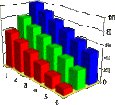How to Analyze Your
Data

Tactics and Vectors will support five levels of participation in data analysis the research program
- Participants can record observations and transmit the data to Tactics and Vectors to
be entered in the database for raw (unprocessed) data. The data will be attributed to you
and made available to other researchers for analysis and will be used to generate maps
showing flight directions.
- Participants can record observations, perform descriptive analyses of the data as
described below, then transmit both to Tactics and Vectors. The data will be entered in
the database for raw data, attributed to you, and made available to other researchers. The
descriptive data will be used to generate maps of flight directions. If you have a good
sample of observations made over the migration period, you should also consider publishing
your analysis in a an appropriate scientific (peer reviewed) journal .
- Participants can record observations, carry out descriptive analyses and hypotheses
testing, then transmit the entire package to Tactics and Vectors for entering in the
database. All information from your study will be attributed to you. Anyone who does this
much work should seriously consider writing a research paper.
- Participants are free to download data to carry out a desired analysis. this is
particularly likely to be of value to compare results from your site to those of other
sites. If your analysis is particularly interesting, please transmit it to Tactics and
Vectors to be entered in database. If you publish, cite Tactics and Vectors as the source
of any downloaded data that was incorporated in your study.
- Participants can download lesson plans to illustrate methods of data analysis and hypothesis testing in behavioral ecology.
Statistical analysis of data submitted to Tactics and Vectors: an overview
You do not have to analyze your data to submit it to Tactics and Vectors. However,
you miss quite a bit of the fun of doing research if you pass up the opportunity to
analyze your own, hard won, data. I remember that I didn't exactly hate statistics as an
undergraduate, but that it was definitely not among the top choices of fun things to do.
As the years passed and I had to perform increasingly detailed analyses of my own data, my
attitude changed and I began to see statistical analysis as interesting, even exciting,
particularly when the results supported my hypotheses.
Standard methods of statistical will be covered in detail in this section, starting with
methods of grouping and graphing raw data, and progressing, in steps, through descriptive
statistics, and hypothesis testing with two-sample tests, and multisample tests. No prior
knowledge of statistics is assumed, although it doesn't hurt. The approach will emphasize
practical application of statistical methods rather than theory. Those of you with little
background in statistics should will probably find that that gaining a moderate degree of
comfort with statistics will alter the way you view the deluge of statistics from the
media. Individuals with a statistics background who would like to check into some of the
references on the fascinating branch of statistical analysis concerned with directional
and periodic data, I recommend Circular Statistics in Biology by Batschelet, E. (1981) and
the last two chapters on statistical analysis of circular distributions in Biostatistical
Analysis, third edition, by Zar, J. (1996).
Batschelet, E. 1981. Circular Statistics in Biology. Academic Press.
Zar, J. 1996. Biostatistical Analysis, third edition. Prentice Hall.